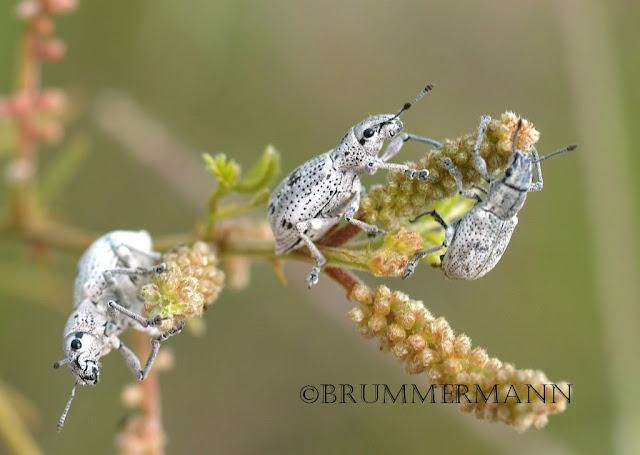 | |
| Dynastes grantii development |
I have been asked repeatedly for the recipe of the wood mulch that I use for beetle larvae that feed on rotting wood. I got this recipe from my friend Bill Kaufman and it really works. Of course you need to prepare it at least 4 weeks ahead of time, so it's late now for Strategus larvae, but still time if you have and egg laying Dynastes female: those eggs take a break till next spring before they'll hatch.
For adults of scarab beetles, I usually use
sieved peat moss for egg laying because it is easy to obtain in large amount
and normally have success with it. Since peat moss usually carries mites that
explode in their numbers very rapidly and cover adults and eggs, I microwave
peat moss in a disposable tupperware (plastic bags can also be used) with a lid
loosely placed on top; I usually put half-gallon container filled with peat
moss in a microwave for about three minutes. After removing the tupperware from
the microwave, I place the lid tightly and let the peat moss cool down for several
hours. The moisture level is important for egg laying. You want the moisture
level to be where peat moss forms a lump when pressed in your hand but easily
breaks when poked by a finger. If a clump does not form, moisture level is too
low. If a clump does not break easily, there is too much water. This rule of
thumb usually applies to other substrate unless you are using very coarse
substrate.
For lucanid egg laying, I do not use peat moss. I bury pieces of rotten wood in compost found in tree holes or homemade substrate. Compost is placed first in a container, and it is compressed hard for the first inch on the bottom. Rotten wood pieces are placed after being soak in water for a few hours. More compost is added to fill air space around rotten wood.
For scarab larvae, I usually mix multiple types of substrate. Compost found in deciduous tree holes is great. I also mix some well-rotten wood after braking it. Finally I add substrate I make. It is probably best to use only the homemade substrate if I can make enough of it. (since most dynastines prefer more decayed substrate than most lucanids do, it takes longer to make ideal substrate for scarabs than lucanids). The below are the steps I follow to make the substrate. Substrate that is commercially available in Japan and that generally produces larger beetles than the ones found in wild is made in a similar way. I sometimes use the homemade substrate only for lucanid larvae instead of mixing multiple types of substrate.
Supplies:
Barbeque wood pellet (I get oak from Ace Hardware)
Water
Yeast
Wheat flour
Plastic tub (10 to 20 gallon)
Large spoon or another item to mix substrate
Measuring cup
Bucket or plastic tub
1. Wash barbeque wood pellet by putting it in hot water in a bucket or another container. Rinse a few times. This process will remove most resin used to make the pellet. It is easier if you wash small amount of pellet at a time instead of trying to wash the whole bag of pellet.
2. Dry the washed wood pellet by placing in/on a tub, lid, newspaper, or tarp. If you make it shallow, it drys faster. The pellet becomes sawdust when it is dry. Make sure that it is completely dry before proceeding to the next step.
3. Add 7 to 8% (10% at most) by volume of wheat flour mixed with a couple of spoons of dry yeast into sawdust. It is very important that the container, sawdust, spoon, and your hands are dry during this step; otherwise, flour will make unwanted clumps, which will cause mold or lead to failure in the substrate making. Mix well so that sawdust and flour are mixed evenly.
4. add warm water and stir. Use enough water to get to a consistency that you can form balls of substrate that don't fall apart, but not more. It's moist, not wet.
5. Stir every day for a week, later once a week. Keep above 40 degrees Fahrenheit. White hyphens should run through all of it and the over all color will darken. But if you find black mold, throw it out, it's spoiled.
Important: The first time I tried this, all the males eclosed earlier than the females. This is normal for many insects. But in the confines of the terrarium, they got to the youg females before the females' exoskeleton had time to harden, and the females were killed. To prevent this sad situation, make sure you separate the male pupae (horned) from the females as soon as you can tell them apart.
Good luck!

























































